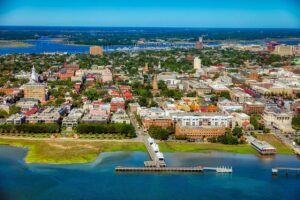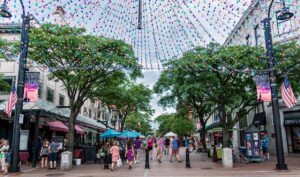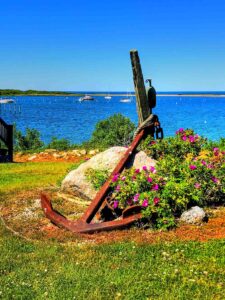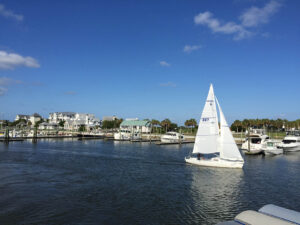The gentle bend in the coastline between Panama City and the Apalachicola River is not merely geographic — it’s also a time arc back to a slower, gentler pace of days long gone. Genteel beach communities with the grace of Old Florida line the shoreline, each exhibiting its own distinct personality.
Starting Point: Panama City Beach
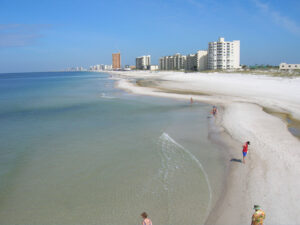
J.S. Clark on Wikimedia Commons
Once the St. Andrews Bay Bridge connected the mainland to the barrier islands, Panama City Beach became an instant resort town repeatedly topping “best beach” lists. The powdery white sand is not only alluring, it’s comfy cool even on the hottest days. Dig in with bare toes; it won’t burn your feet. In a dazzling dance with light, the watercolor shifts between emeralds and blues.
Drop anchor just offshore or catch the shuttle to nearby Shell Island. Seven miles of elegant sand dunes and native plant life are home to nesting shorebirds, ghost crabs and endangered species including Choctawhatchee beach mice, plovers, and loggerhead and green sea turtles.
Unique gems with that irresistible beach vibe await discovery at the Coastal Design Emporium Trail. Charming local shops range from beach-meets-Boho thrift and vintage stores to home and clothing boutiques overflowing with the ultimate in coastal chic.
Known for fishing since the Civil War when local watermen supplied salt fish to the Confederate army, Panama City Beach still excels in fresh coastal cuisine. Bayou Bill’s Crabhouse serves crabs, oysters and seafood with a sprinkle of Cajun flavor. Paula Deen’s Family Kitchen mixes warm Southern hospitality into classic down-home dishes. Authentic New York City pastrami and tiramisu are favorites from Paparazzi Gourmet Deli’s menu derived from 100 years of family recipes.
Full-service Treasure Island Marina has 80 slips to 70 feet, fuel and a state-of- the-art service department.
Leg 1: Mexico Beach
Estimated Mileage: 29.4 NM
Lovingly nicknamed “Mayberry on the Water,” Mexico Beach has restrained commercial development to keep its natural beach village charm. As an ecotourism town, it actively protects nesting marine turtles and their hatchlings by limiting artificial light sources and new coastal construction.
In the fall of 2018, preservation turned to survival when Hurricane Michael leveled most of Mexico Beach. With determination and help from surrounding communities, rebuilding is nearly complete. The landscape has been altered, but the heart and soul of Mexico Beach remains unchanged.
The town may lack traffic jams and overcrowded beaches, but there is no shortage of cool beach eats. Stop into Mango Marley’s for Floribbean food or a cooling Watermelon Margarita. Killer Seafood’s menu features calamari tacos, a Killer Bread Bowl filled with shrimp or scallops, and a homemade sweet potato pecan pie that no one has room for but orders anyway.
Mexico Beach Marina is full-service and well equipped with everything you need: ethanol-free gas, a fully stocked ship store, plus bike and kayak rentals.
Leg 2: Port St. Joe
Estimated Mileage: 10.6 NM
Once a bustling port on St. Andrews Bay, Port St. Joe has a neat, easily walkable downtown with bistros, shops and a scattering of green spaces. A museum explains the prominent role the town played in Florida history with the drafting and signing of the Constitution at the state’s first Constitutional Convention.
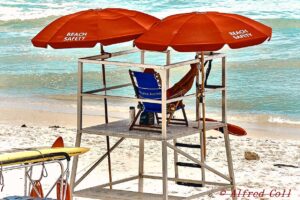
Area wrecks provide a perfect landscape for snorkeling or fishing, and in summer charter expeditions harvest the famous bay scallop. In June, Port St. Joe hosts the Annual Forgotten Coast Sea Turtle Festival, and in October, the Blast on the Bay Songwriters’ Festival.
Eating options go beyond beach bar shacks. Skully’s has three menu choices: gumbo, steamed shrimp or The Lowcountry Boil. For a culturally diverse menu, try Provisions. Then join the line at Shoobie’s for gelato and soft-serve sundaes voted best on the coast year after year.
Following repeated hurricane damage, several marinas have converted to dry storage, but Captain’s Cove Marina has a couple of lay-along spots for transients and an easily accessible fuel dock. Owned by the Raffield family watermen since the 1800s, the facility sits at the mouth of the bay on the St. Joseph Canal and ICW.
Leg 3: Apalachicola
Estimated Mileage: 19.9 NM
The fishing village of Apalachicola has deep maritime roots. Previous generations made a living on the bay, first in oystering and then, with the arrival of Greek immigrants in the 1900s, the sponge trade. The city still maintains a working waterfront where oyster harvesters and shrimpers dock their workboats.
Oysters, as well as the local specialty, the grouper sandwich, appear on most menus. The fusion of Japanese, French and Southern cuisines give old favorites a new zest at The Franklin at the Gibson. Why even try to resist Apalachicola Chocolate & Coffee Company’s handmade chocolate, gelato, caramel turtles and French pudding truffles?
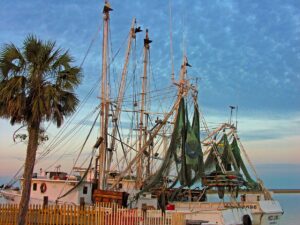
Best known for seafood, Apalachicola is also a haven for creatives. Folk artists, actors and writers flourish here! Artist studios are tucked behind houses and above commercial spaces. The Apalachicola Center for History, Culture & Art occupies one of three remaining 1840s shipping warehouses on the riverfront. John Gorrie Museum State Park relates the story of the 19th century doctor who in an attempt to make his yellow fever victims more comfortable, invented an ice-making machine, the forerunner of air conditioning.
“Apalach” is an eclectic mix of low and slow — no high rises here. The city, modeled after Philadelphia with wide streets and squares, is easily walkable. Trendy shops mix gracefully with historic brick front buildings. More than 900 structures housing boutiques, shops, galleries and restaurants are listed on the National Register of Historic Places. Just off the main street is an enchanting neighborhood of turreted Victorian houses and stained-glass wooden churches.
Water Street Marina on Scipio Creek, four blocks from downtown, has 19 transient slips for boats to 55 feet. Fuel is available at nearby Scipio Creek Marina.
If it seems impossible to change your sand covered flip-flops for real shoes or to trade the sound of breaking waves for the clamor of ringing phones, cruise a bit farther along the coast. Several laid-back beach towns such as St. George Island’s Beach, Eastpoint, Alligator Point and Carrabelle, with their rustic seafood shacks and weatherworn docks, offer one more chance for sandy solitude and stunning natural beauty.


